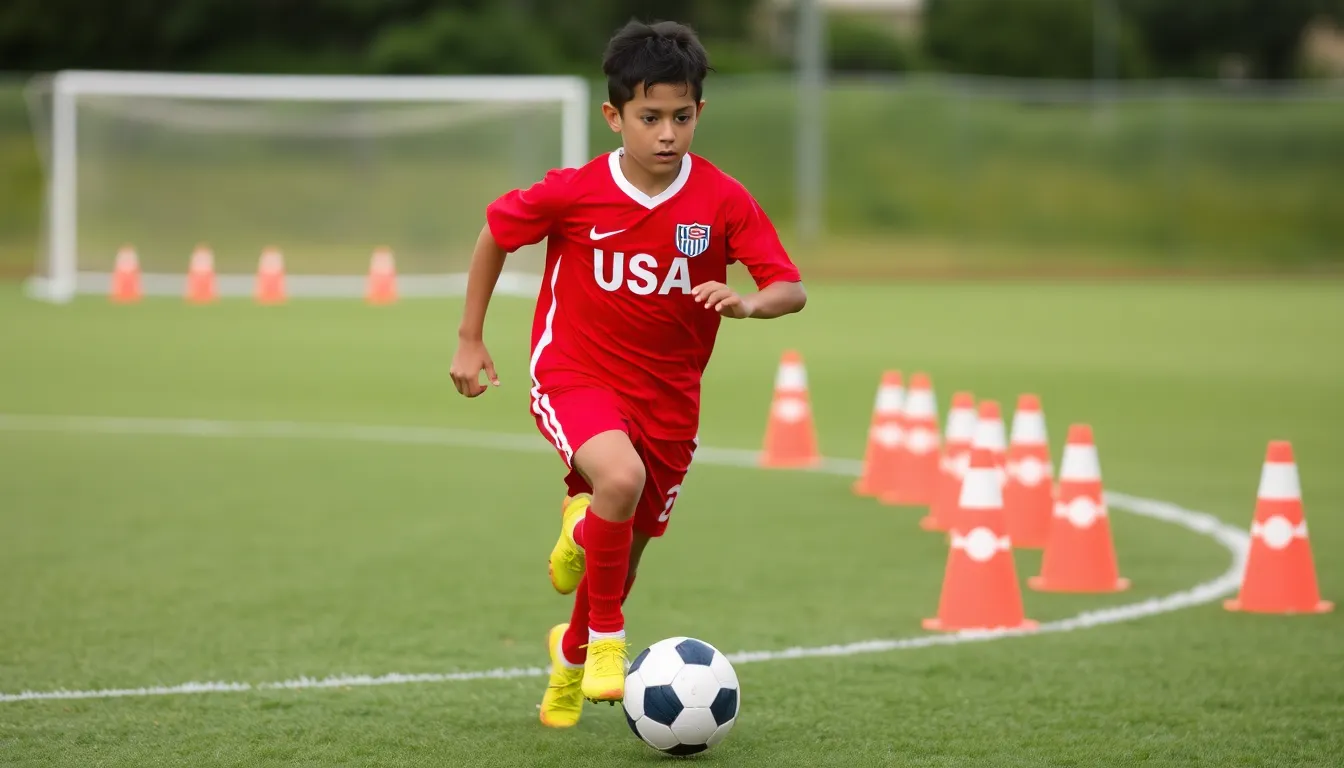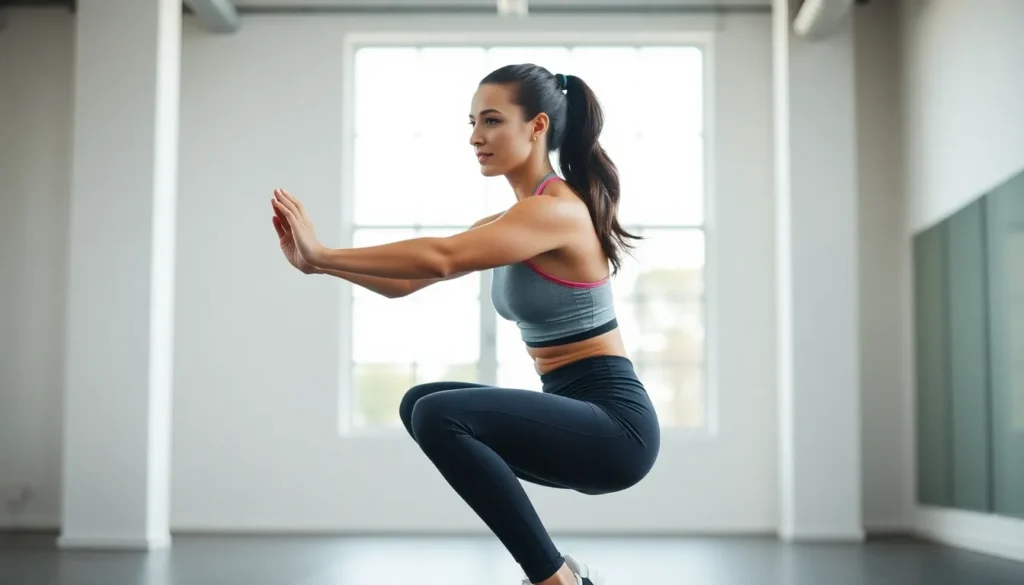When it comes to soccer, agility and endurance can make the difference between a glorious goal and a faceplant on the field. Soccer fitness training isn’t just about running laps until you can’t feel your legs; it’s a dynamic blend of strength, speed, and stamina that transforms players into unstoppable forces. Imagine weaving through defenders like a gazelle on a caffeine high—that’s the power of proper training.
Table of Contents
ToggleUnderstanding Soccer Fitness Training
Soccer fitness training encompasses various elements that contribute to a player’s overall performance. Effective training focuses on developing agility and endurance alongside strength, speed, and stamina.
Importance of Fitness in Soccer
Fitness plays a vital role in soccer. Improved athletic ability enables players to execute skills with precision. High levels of fitness allow players to maintain intensity throughout matches, ensuring they can perform optimally from start to finish. Conditioning directly influences a team’s ability to outlast opponents in both physical and strategic aspects. Also, players with better fitness levels often exhibit quicker recovery times, reducing injury risk.
Key Components of Fitness for Soccer Players
Soccer players must prioritize multiple fitness components. Strength training builds muscle power essential for tackling and shooting. Speed drills enhance quick bursts of acceleration necessary for breaking past defenders. Endurance workouts allow athletes to sustain high activity levels for the duration of a match. Agility exercises foster quick directional changes, a critical skill in evasive maneuvers. Flexibility training supports overall movement efficiency, contributing to reduced injury chances during gameplay.
Types of Soccer Fitness Training

Soccer fitness training includes several key components that enhance a player’s overall performance. These components focus on endurance, strength, agility, and speed.
Endurance Training
Endurance training boosts a player’s ability to sustain high energy levels throughout matches. Long-distance running and interval training are effective methods to build cardiovascular endurance. Incorporating activities like cycling or swimming improves stamina while reducing impact on joints. High-intensity interval training (HIIT) also plays an essential role in developing aerobic capacity and recovery speed. Consistent endurance workouts enable players to maintain performance levels, especially in the latter stages of games.
Strength Training
Strength training enhances muscle power and overall athleticism. Core exercises, weightlifting, and bodyweight workouts effectively build upper and lower body strength. Focused strength routines improve explosive movements that contribute to better shooting, passing, and defending. A well-rounded strength training program targets major muscle groups to ensure balanced development. This approach not only increases on-field performance but also minimizes the risk of injury through enhanced muscle support.
Agility and Speed Training
Agility and speed training increases rapid directional changes and quick accelerations. Ladder drills, cone drills, and short sprints effectively improve foot speed and coordination. Plyometric exercises, such as jump squats, enhance explosive power required for sprinting. Incorporating reaction drills mimics game situations and enhances decision-making speed. Combined, these workouts prepare players to maneuver effectively, making them difficult to defend against during matches.
Designing a Soccer Fitness Training Program
Designing an effective soccer fitness training program requires a systematic approach. A thorough understanding of current fitness levels serves as the foundation for progress.
Assessing Current Fitness Levels
Assessing fitness begins with baseline evaluations of strength, speed, endurance, and agility. Measuring VO2 max provides insights into cardiovascular endurance. Additionally, timed sprints can establish speed benchmarks. Strength tests, such as the squat or bench press, gauge muscle power. Fitness assessments should occur regularly to track improvements and adjust training as necessary.
Setting Goals and Objectives
Setting specific, measurable, achievable, relevant, and time-bound (SMART) goals enhances training efficacy. For example, improving sprint time by 0.5 seconds within six weeks creates a targeted focus. Goals can encompass areas like increasing endurance to last 90 minutes or enhancing agility to execute precise cuts. Communicating these objectives to players increases motivation and accountability.
Creating a Balanced Routine
Creating a balanced routine involves integrating various training elements. Incorporate strength training exercises, agility drills, and endurance workouts for a comprehensive program. For instance, alternating between weightlifting and sprint drills within a weekly schedule ensures muscle recovery while enhancing fitness. Prioritizing flexibility training, such as yoga or stretching, helps reduce injury risks and improves overall performance. Adapting routines based on seasonal competition and training phases helps maintain peak physical condition.
Incorporating Drills into Training
Incorporating specific drills into training enhances a soccer player’s overall fitness and performance. Each drill targets unique skills essential for success on the field.
Skill-Specific Drills
Skill-specific drills focus on particular techniques crucial for gameplay. Dribbling drills, for instance, help players improve ball control while navigating through obstacles. Shooting drills enhance accuracy and power, ensuring players can capitalize on goal-scoring opportunities. Passing drills facilitate teamwork and communication, vital for maintaining possession. Defenders benefit from positioning drills, honing their ability to anticipate an opponent’s movements. Prioritize these skill-specific drills to develop a well-rounded skill set.
High-Intensity Interval Training (HIIT)
High-intensity interval training (HIIT) offers an effective way to boost endurance and power. Short bursts of intense activity, such as sprinting or agility drills, followed by brief rest periods challenge the cardiovascular system. This type of training mirrors the demands of a soccer match, where players frequently alternate between high exertion and recovery. Incorporate HIIT sessions into weekly training routines to enhance overall stamina and explosive strength. Engaging in HIIT regularly ensures players stay prepared for the fast-paced nature of the game.
Recovery and Flexibility Work
Recovery and flexibility work play a vital role in a soccer player’s training regimen. Stretching routines help maintain flexibility in muscles, reducing the risk of injuries during gameplay. Incorporating foam rolling techniques aids in muscle recovery and alleviates soreness after intense training sessions. Additionally, yoga can improve balance and core strength, contributing to overall athletic performance. Setting aside dedicated time for recovery techniques ensures players maintain peak condition throughout the season. Integrating recovery and flexibility work supports longevity in a soccer player’s career.
Soccer fitness training is a multifaceted approach that significantly impacts a player’s performance on the field. By focusing on agility endurance strength and speed players can enhance their abilities to navigate the game effectively. A well-rounded training program not only improves athletic performance but also reduces injury risk ensuring longevity in a player’s career.
Incorporating specific drills and recovery techniques is essential for maintaining peak physical condition throughout the season. As players commit to their fitness journey they’ll find that the benefits extend beyond the game enhancing overall athleticism and skill execution. Prioritizing fitness is a crucial step toward achieving success in soccer.






